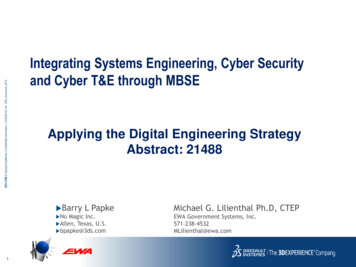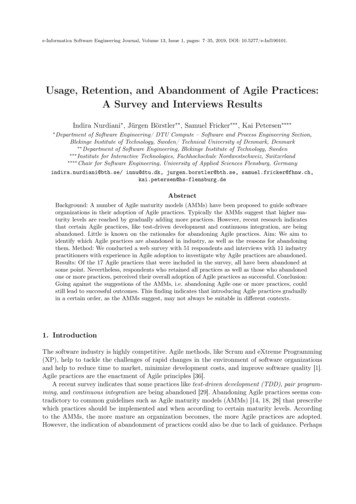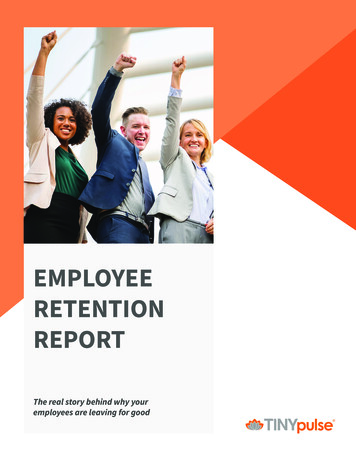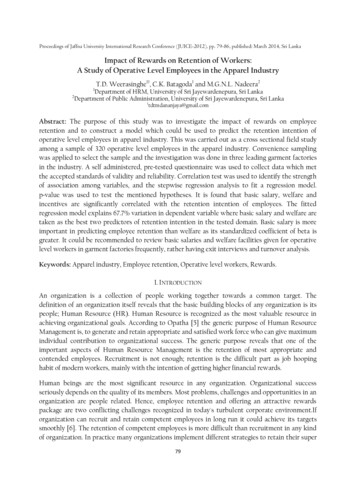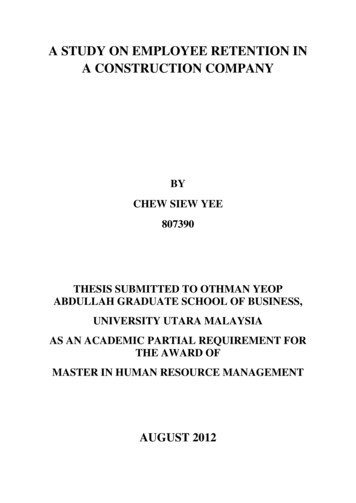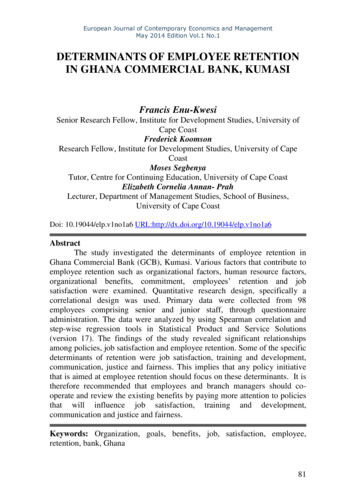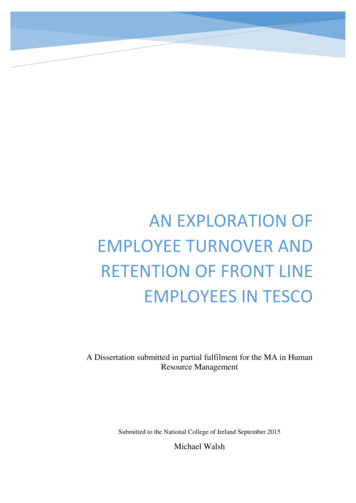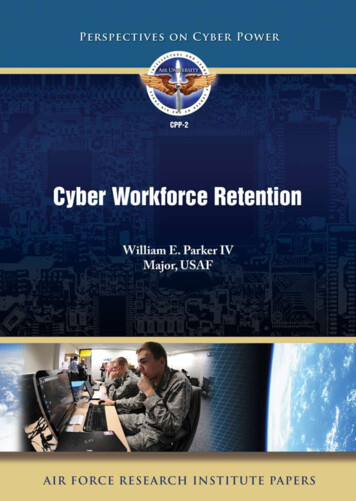
Transcription
Air UniversitySteven L. Kwast, Lieutenant General, Commander and PresidentAir Force Research InstituteDale L. Hayden, PhD, Director
AIR UNIVERSITYAir Force Research InstitutePerspectives on Cyber PowerCyber Workforce RetentionWilliam E. Parker IVMajor, USAFCPP–2Air University PressAir Force Research InstituteMaxwell Air Force Base, Alabama
Project EditorJeanne K. ShamburgerCopy EditorCarolyn BurnsCover Art, Book Design, and IllustrationsDaniel ArmstrongComposition and Prepress ProductionNedra O. LooneyPrint Preparation and DistributionDiane ClarkAIR FORCE RESEARCH INSTITUTEAIR UNIVERSITY PRESSDirector and PublisherDale L. Hayden, PhDEditor in ChiefOreste M. JohnsonManaging EditorDr. Ernest Allan RockwellDesign and Production ManagerCheryl KingAir University Press600 Chennault Circle, Building 1405Maxwell AFB, AL af.mil/http://afri.au.af.mil/Library of Congress Cataloging-in-Publication DataNames: Parker, William E., IV, 1973- author. Air University(U.S.). Air Force Research Institute, issuing body.Title: Cyber workforce retention / William E. Parker IV.Other titles: Air Force Research Institute perspectives on cyberpower ; CPP-2.Description: Maxwell Air Force Base, Alabama : Air UniversityPress, Air Force Research Institute, 2016. Series: Perspectiveson cyber power,ISSN 2329-5821 ; CPP-2 Includes bibliographical references.Identifiers: LCCN 2016036505 ISBN 9781585662647Subjects: LCSH: Cyberspace—Military aspects—United States. United States. Strategic Command (2002- ). Cyber Command. Information warfare—United States. United States. AirForce—Recruiting, enlistment, etc. Airmen—United States.Classification: LCC U167.5.C92 P37 2016 DDC 355.3/43—dc23 SUDOC D 301.26/31:2LC record available at https://lccn.loc.gov/2016036505Published by Air University Press in October 2016DisclaimerOpinions, conclusions, and recommendations expressed or impliedwithin are solely those of the author and do not necessarily representthe views of the Air Force Research Institute, Air University, the UnitedStates Air Force, the Department of Defense, or any other US government agency. Cleared for public release: distribution unlimited.Air Force Research Institute Perspectives on Cyber PowerWe live in a world where global efforts to provide access to cyberresources and the battles for control of cyberspace are intensifying.In this series, leading international experts explore key topics oncyber disputes and collaboration. Written by practitioners andrenowned scholars who are leaders in their fields, the publications provide original and accessible overviews of subjects aboutcyber power, conflict, and cooperation.As a venue for dialogue and study about cyber power and itsrelationship to national security, military operations, economicpolicy, and other strategic issues, this series aims to provide essential reading for senior military leaders, professional militaryeducation students, and interagency, academic, and privatesector partners. These intellectually rigorous studies draw on arange of contemporary examples and contextualize their subjects within the broader defense and diplomacy landscapes.AFRIAir Force Research InstituteThese and other Air Force Research Institute studies are availablevia the AU Press website at http://aupress.au.af.mil/papers.asp.Please submit comments to afri.aupress@us.af.mil.
ContentsList of IllustrationsvAbout the AuthorviiPrefaceixAcknowledgmentsxiAbstractxiii1 Rising Demand for Private-Sector Cyber Skills 12 Air Force Cyber Warfare Operations (1B4X) 9Evolution of Air Force Cyber Warriors9Career Field Health14Career Field Challenges183 Retention 25Congressional Concerns about Cyber Retention25Contemporary Civilian Labor Market StudyFindings on Retention Best Practices26Department of Defense Retention Tools andPractices: Special and Incentive Pays28Models to Measure Retention and Specialand Incentive Pay Effectiveness30General Findings on the Efficiency of Specialand Incentive Pays in Supporting Retention314 Final Analysis and Recommendations 37Review of Findings37Final Analysis and Recommendations39Abbreviations47Bibliography49iii
IllustrationsFigure1Training pipeline for award of cyber AFSC122Cyber operator cyber mission resilience road map133Inventory of 1B4 Airmen by YOSs164Inventory of total enlisted Air Force by YOSs1751B4X1 retention decision points2061B4X1 separation factors2271B4X1 reenlistment factors238Paralegal career field (5J0X1) sustainment as of February 201541Table11B4X manning end of FY 2011–February 2015102Zone manning end of FY 2011–February 2015113Retention trends and goals September 2012–February 201519v
About the AuthorMaj William E. Parker IV is the operations officer for the 51st Force Support Squadron, Osan AFB, Republic of Korea, and assists the commanderwith all personnel and manpower functions that support USAF operationsacross the Korean peninsula. He has served in various squadron-level baseoperations support positions leading a combined team of military personneland civilians managing installation temporary lodging facilities, appropriatedand nonappropriated food service facilities, fitness and sports centers, libraries, mortuary affairs services, civilian and military human resources, andsquadron contingency programs. He has also held several Pentagon assignments, including chief, Air Force Fitness and Lodging Policy; deputy chief,A1 Issues Team; executive officer, Air Force Directorate of Services; and AirForce Strategic Policy Fellow, US Department of Labor and the Office of theUnder Secretary of Defense for Personnel and Readiness. Major Parker hasdeployed multiple times in support of Operations Iraqi and Enduring Freedom,including as a deployed squadron commander. He holds a bachelor of sciencedegree in public administration, Evangel University, Missouri; a master ofscience degree in personnel management, Troy University, Alabama; and amaster of science degree in international hospitality management from theUniversity of South Carolina.vii
PrefaceI have to admit I chose this topic based on personal curiosity combinedwith my associated lack of knowledge of cyber warfare and cyber-skilled personnel. This motivation was certainly increased by the current environment.In one news headline, you read of major force reductions the military servicesare experiencing and predicting under the shadow of the pending return ofsequestered budgets in fiscal year 2016. On the following page is a “call toarms” of sorts regarding the need to drastically increase our nation’s uniformed cyber-skilled operators. This dichotomy in itself was fascinating, leadingme to question the Air Force’s ability to retain and grow our cyber forceswhile simultaneously shedding or stagnating the growth of personnel inalmost every other operational community.I was originally inspired to conduct my study by the Air Force decision inthe fall 2014 to establish a distinct cyber operations Air Force specialty code(AFSC) for officers (17S) and to investigate methods and policies to supportthis new career field’s growth and retention. However, once I began to researchthe expanding cyber mission within the Air Force, I learned that in reality Airmen from several officer and enlisted AFSCs are involved in the Air Force’scyber operations. They include the enlisted 3DX cyberspace support personneland 1NX intelligence personnel as well as 14N intelligence officers and the17D/S cyber operations officers who lead and manage Air Force cyber operations. I soon learned that it is the 1B4 enlisted Airman who possesses thehighest proficiency of technical cyber skills and on a daily basis is the true“operator, trigger puller” for the Air Force in cyberspace. Further, these Airmenhave the cyber skills most desired in both the public and private sectors.Ultimately, my final motivation in settling on this topic is my strong feelingthat the Department of Defense’s increased focus, energy, and resourcesdirected toward growing our defensive and offensive operational capabilitiesin the cyber domain are necessary and justified. The most critical element insupporting this effort is to ensure that we supply human capital that can successfully operationalize this domain.ix
AcknowledgmentsA study such as this one cannot be accomplished without the support ofothers, and I am overwhelmingly thankful to those individuals who contributedtheir knowledge and expertise. Most critical to providing the background andcontext for the evolution of the 1B4s in support of this research was CMSgtJohn Sanders, career field manager for the 1B4s at the time this paper wasdrafted. Without his outstanding and supportive cooperation, this projectwould not have been possible. Other key contributors were Capt ChristopherPrice and 2d Lt Greg Renner from the US Air Force Directorate of ForceManagement Policy (AF/A1P); they provided superb support, undergirdingmy knowledge on the metrics associated with career field health and sustainment. I would also like to thank Mr. Steve Galing and Mr. Bill Doughertyfrom the Office of the Secretary of Defense’s Compensation Policy Office;they provided me with great insights into the historical use of compensationtools to support retention in the Department of Defense. Finally, I would liketo recognize Dr. Panayotis Yannakogeorgos, Air Force Cyber College, for hisacademic advisement and guidance for this project and Ms. Jeanne Shamburger,Air Force Research Institute, for transforming my initial drafts into this comprehensible final product. I thank you all.xi
AbstractExperienced cyber and information security professionals will be membersof one of the fastest growing and in-demand occupational categories in the labormarkets in the United States and around the world in the coming years. Thisdemand is increasing based on the rising threat of cyber incidents, the burgeoning cost of doing business due to cybersecurity infiltrations, and corporateAmerica’s / senior executives’ growing awareness of and focus on the need toenlarge cybersecurity capabilities in the private sector. The escalating call forcybersecurity professionals collides with a world labor market already experiencing a dramatic deficit in individuals with these skills.At the same time, the United States Air Force is dramatically increasing thesize and capability of its cyber forces to meet its increased contribution to USCyber Command’s (USCYBERCOM) cyber mission forces. The Air Force’s enlisted 1B4X Airmen, Cyber Warfare Operations, will be on the leading edge ofthis contribution to USCYBERCOM. However, this new career field is currently manned at 46 percent, principally due to rapidly increasing requirements.The Air Force specialty code’s approximately 210 initial authorizations when itwas established in fiscal year (FY) 11 may grow to as many as 880 authorizationsby FY 16. This paper’s focus is on developing strategic recommendations to effectively retain and sustainably build the Air Force’s workforce of 1B4 cyberAirmen, who possess these highly desirable, portable cyber skill sets. Such development will be most critical in the next few years as the Air Force continuesto increase its contribution to the nation’s cyber mission forces in this new andexciting warfare domain.This study first overviews the current cybersecurity human capital environment, specifically exploring the increased demand and associated shortage forcybersecurity experts in the marketplace. It then examines the evolution of anew breed of warrior—the Air Force’s 1B4 cyber Airmen—and the plan tomove this emerging career field from growth to future sustainment. As part ofthis examination, this study assesses the Air Force’s current retention of thesehighly skilled Airmen. This assessment is followed by a review of contemporarypublic-sector retention studies and initiative findings, which could prove usefulin supporting the retention of cyber Airmen. Also analyzed are Department ofDefense retention tools, primarily in the form of special and incentive pays, todetermine their effectiveness in supporting retention within the armed forcesand their potential application in supporting cyber Airmen retention as measuredby recent research and studies. Finally, this study summarizes recommendedinitiatives and focus areas to support not only retention of cyber Airmen but alsogrowth and sustainability of this fledgling career field.xiii
Chapter 1Rising Demand for Private-Sector Cyber SkillsGrowth in demand [for cyber personnel] continues to far outnumberthe personnel capable of protecting our networks.—Cong. Jim Langevin (D-RI)Experienced cyber and information security professions will be one of thefastest developing and in-demand occupational categories in the UnitedStates and around the world in the coming years. Recent, highly publicizedcriminal-underworld hacking incidents directed against recognizable andtrusted companies in the private sector include Target Corporation, the HomeDepot, J. P. Morgan, and Sony Pictures Entertainment. These occurrenceshave only highlighted the increased threat to our nation in cyberspace andfueled the fire in private-sector demand for those with cybersecurity expertise. Perpetrators can be single, reclusive attackers who attempt to penetratenetworks from the comforts of home. They can also belong to large, wellfunded, organized criminal rings with deep pockets; a host of computing resources; and professional, trained hackers at their disposal. Other threats continue to emerge from unseen state-sponsored assailants who blur the linesbetween criminal intent and acts of national aggression—witness the Sonyhacking incident in late 2014. While the motivations and resources availableto potential attackers in the cyber sphere are diverse and warrant differentnational responses, the rising and varied threats in cyberspace have led thepublic and private sectors to become more aware of their vulnerability in thatrealm. This realization has led to a rapidly growing demand for cyber-skilleddefenders—who are increasingly in short supply.For the United States Air Force, enlisted 1B4 cyber-warfare operations Airmenare on the leading edge of cyber defensive and offensive operations. Thepresent demand for cybersecurity specialists in both the public and privatesectors could undoubtedly lead the Air Force to be significantly challenged inretaining its most developed and experienced cyber Airmen in the yearsahead. Airmen in several officer and enlisted Air Force specialty codes (AFSC)are involved in Air Force cyber operations, including enlisted 3DX cyberspaceMajor Parker wrote this paper in June 2015 as an Air Force Fellow.1
support personnel, 1NX enlisted intelligence personnel, 14N intelligenceofficers, and 17D/S cyber operations officers who lead and manage Air Forcecyber operations. It is the 1B4 Airmen, however, who possess the highest levelof technical cyber proficiency and on a daily basis are the true “operators, trigger pullers” in cyberspace. They have the cyber experience most desired inboth the public and private labor-market sectors. Consequently, this paperfocuses on developing a strategy to effectively retain and sustainably build theAir Force’s workforce of 1B4 cyber Airmen with these highly desirable, portable cyber skill sets. Doing so will be most critical in the next few years as theAir Force continues to increase its contribution to the nation’s cyber missionforces in this new and exciting warfare domain.We are experiencing what the Center for Strategic and International Studies(CSIS) and many others have described as a “human capital crisis” in the cybersecurity workforce, where demand continues to outpace supply. It is estimatedthat today 30,000 unfilled cybersecurity jobs exist in the US federal government sector alone.1 According to the International Information System SecurityCertification Consortium (ISC), the US public and private demand will increase11 percent per year over the next few years.2 Some estimates have placed theworldwide public and private workforce shortage for cybersecurity professionals at close to one million and counting.3 However, it is worth noting thatthese shortages are somewhat ill defined in that “cyber skilled” personnel tendto be grouped into a singularly defined category of “cyber skills.” In reality, theskill set is varied and can range from supporting local informational technology,engineering infrastructure, and conducting data analytics to writing cyber codeor hacking. The latter is often the most difficult skill set for human resourceprofessionals to identify within the labor pool and recruit.4 In the currentenvironment, shortages in all flavors of cyber experts will increase, at least inthe foreseeable future. Demand for all varieties of cybersecurity-skilled experts in both the private and public sectors is only rising.What is driving this increased demand? Without question, recent hackingevents that have continued to play out in the daily news and have grabbedAmerican and world headlines only fuel it. Each of these events has been increasingly damaging, cumulatively draining the targeted organizations ofmillions of dollars in stolen or unrealized revenues, exposing millions of theircustomers to identity theft and fraud, and, in the case of Sony, threateningconstitutional liberties. Few people understand that these major and widelypublicized hacking events barely scratch the surface of the current and emergingcyber threat.Part of the problem is that cyber events spring from myriad sources withequally diverse motivations, spanning individual hacktivists and criminals,2
terrorists, organized crime, and state actors—including foreign-sponsored intelligence or military organizations. While these players differ in their motivationsand capabilities to perform nefarious acts in cyberspace using a diverse andever-growing list of cyber weapons, more importantly, the trend of major cyberevents is only worsening—capturing national interest. Since 2006 the CSIShas maintained a listing of major cyber events, which it defined as any successful attack against a government or company resulting in a significant lossof data or a million dollars or more. From May 2006 through 15 December2014, it recorded 172 major cyber incidents. One case in 2012 indicated thatthe Chinese had accessed classified information regarding vulnerabilities ofthe F-35 Joint Strike Fighter—the most costly weapon-system investment inUS history. Another was a criminal hacking scheme in Oman and the UnitedArab Emirates in 2013 involving eight individuals who stole more than 45million. The listing includes 66 reported events in the first four years from thelist’s creation in May 2006 to May 2010, followed by 88 events in the followingfour years by the end of May 2014. Unfortunately, the upward trend in majorevents has only continued from June through December 2014, when 18additional major events were reported on the list in seven short months.5Clearly evidenced in a review of this incident list is the steady rise of the frequency and boldness of major cyber incidents. Moreover, the costs are escalating for each incident not only in terms of direct and immediate financialloss but also in prestige and public confidence for those companies involved,ultimately leading to further fiscal damage.Cybercrime is now estimated to suck at least 400 billion from the globaleconomy. This staggering figure is more than the gross domestic product(GDP) of many nations’ economies, and it is estimated that these losses willonly increase in future years.6 This stunning statistic would lead most organizations in today’s global economy to act to increase their cybersecurity. However, many of them have maintained an unwarranted level of self-security incyber, naively believing they were immune to such damaging losses. Whilethe recent highly publicized hacking event
May 11, 2017 · the views of the Air Force Research Institute, Air University, the United States Air Force, the Department of Defense, or any other US govern-ment agency. Cleared for public release: distribution unlimited. Copy Editor Carolyn Burns Cover Art, Book Design, and Illustrations Daniel Arms

